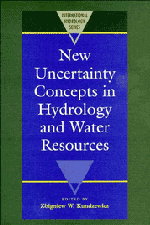Book contents
- Frontmatter
- Contents
- List of Authors
- Preface
- I INTRODUCTION
- II FACETS OF UNCERTAINTY
- III NOVEL APPROACHES TO UNCERTAINTY: FRACTALS, FUZZY SETS AND PATTERN RECOGNITION, NON-PARAMETRIC METHODS
- IV RANDOM FIELDS
- V TIME SERIES AND STOCHASTIC PROCESSES
- 1 Prediction uncertainty in seasonal partial duration series
- 2 A daily streamflow model based on a jump-diffusion process
- 3 The influence of time discretization on inferred stochastic properties of point rainfall
- 4 The distribution of the l-day total precipitation amount
- 5 Analysis of outliers in Norwegian flood data
- 6 Stochastic modelling of the operation of hydrants in an irrigation network
- 7 Order and disorder in hydroclimatological processes
- 8 Towards the physical structure of river flow stochastic process
- VI RISK, RELIABILITY AND RELATED CRITERIA
6 - Stochastic modelling of the operation of hydrants in an irrigation network
Published online by Cambridge University Press: 07 May 2010
- Frontmatter
- Contents
- List of Authors
- Preface
- I INTRODUCTION
- II FACETS OF UNCERTAINTY
- III NOVEL APPROACHES TO UNCERTAINTY: FRACTALS, FUZZY SETS AND PATTERN RECOGNITION, NON-PARAMETRIC METHODS
- IV RANDOM FIELDS
- V TIME SERIES AND STOCHASTIC PROCESSES
- 1 Prediction uncertainty in seasonal partial duration series
- 2 A daily streamflow model based on a jump-diffusion process
- 3 The influence of time discretization on inferred stochastic properties of point rainfall
- 4 The distribution of the l-day total precipitation amount
- 5 Analysis of outliers in Norwegian flood data
- 6 Stochastic modelling of the operation of hydrants in an irrigation network
- 7 Order and disorder in hydroclimatological processes
- 8 Towards the physical structure of river flow stochastic process
- VI RISK, RELIABILITY AND RELATED CRITERIA
Summary
ABSTRACT The irrigation system design of pressurized networks is often dimensioned based on the probability of hydrant operation. Simple statistical techniques have been extensively used in the past to model the hydrants operation and to calculate the design capacity of each reach of the network. Such methods as, for example, Clemment's ‘on demand’ approach, are adopted by designers and agencies in the design of irrigation systems. The objective of this paper is to attempt to model the hydrants operation in the irrigation network using the Alternating Renewal Process in continuous time. Extensive data were gathered from collective irrigation networks in Crete. These data were used to estimate the parameters of the Alternating Renewal Process model. A graphical representation of the results could assist in drawing useful conclusions.
INTRODUCTION
Design of collective pressurized irrigation systems is often based on the probability of hydrants operation. The method known as ‘on demand’ was introduced by Clemment (1955) for the estimation of peak season discharge requirements. Therefore the probability of operation of hydrants as a design factor has a significant effect on the overall economy of the irrigation project (construction, operation and management). Common practice for the description of the demand pattern when designing an irrigation project is to calculate a probability of hydrant operation based on earlier experience or on assumed pattern of operation.
Numerous studies on modelling irrigation networks can be found in the literature.
- Type
- Chapter
- Information
- New Uncertainty Concepts in Hydrology and Water Resources , pp. 252 - 256Publisher: Cambridge University PressPrint publication year: 1995

